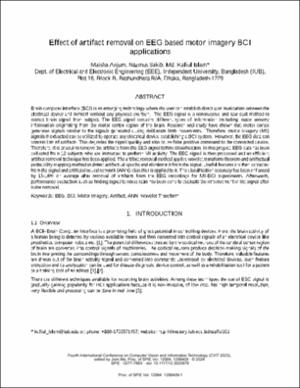| dc.contributor.author | Islam, Md Kafiul | |
| dc.contributor.author | Sakib, Nazmus | |
| dc.contributor.author | Anjum, Maisha | |
| dc.date.accessioned | 2024-03-07T18:50:53Z | |
| dc.date.available | 2024-03-07T18:50:53Z | |
| dc.date.issued | 2024-01-29 | |
| dc.identifier.citation | Anjum, Maisha, Nazmus Sakib, and Md Kafiul Islam. "Effect of artifact removal on EEG based motor imagery BCI applications." In Fourth International Conference on Computer Vision and Information Technology (CVIT 2023), vol. 12984, pp. 69-78. SPIE, 2024. | en_US |
| dc.identifier.uri | http://ar.iub.edu.bd/handle/11348/941 | |
| dc.description.abstract | Brain computer interface (BCI) is an emerging technology where the user can establish direct communication between the electrical device and himself without any physical exertion. The EEG signal is a noninvasive and low-cost method to extract brain signal from subject. The EEG signal contains different types of information including motor sensory information originating from the motor cortex region of the brain. Research and study have shown that motor cortex generates signals similar to the signals generated during deliberate limb movements. Therefore, motor imagery (MI) signals if extracted can be utilized to operate any electrical device establishing a BCI system. However, the EEG data can contain lots of artifacts. This degrades the signal quality and also cause false positive command to the connected device. Therefore, it is crucial to remove the artifacts from the EEG signal before classification. In this project, EEG data has been collected from 12 subjects who are instructed to perform MI activity. The EEG signal is then processed and an efficient artifact removal technique has been applied. The artifact removal method applies wavelet transform theorem and artifactual probability mapping method to detect artifactual epochs and eliminate it from the signal. Useful features are then extracted from the signal and artificial neural network (ANN) classifier is applied to it. The classification accuracy has been enhanced by 15-16% on average after removal of artifacts from the EEG recordings for MI-BCI experiments. Afterwards, performance evaluation such as finding signal to noise ratio has been done to evaluate the improvement in the signal after noise removal. | en_US |
| dc.description.sponsorship | The research is funded by IUB Sponsored Research Grant Ref. #2019-SECS-11. | en_US |
| dc.language.iso | en_US | en_US |
| dc.publisher | SPIE Digital Library | en_US |
| dc.relation.ispartofseries | Fourth International Conference on Computer Vision and Information Technology (CVIT 2023);vol. 12984, pp. 69-78 | |
| dc.subject | EEG | en_US |
| dc.subject | BCI | en_US |
| dc.subject | Motor Imagery | en_US |
| dc.subject | Artifact Removal | en_US |
| dc.subject | Machine Learning | en_US |
| dc.title | Effect of artifact removal on EEG based motor imagery BCI applications | en_US |
| dc.type | Article | en_US |
